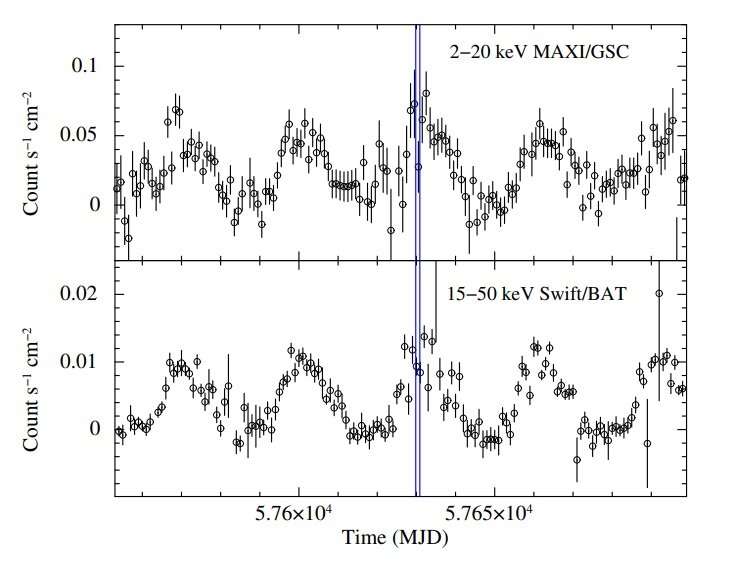December 12, 2022 report
Observations explore the properties of X-ray binary LMC X–4

Using the AstroSat spacecraft, Indian astronomers have investigated a high mass X-ray binary system known as LMC X–4. Results of the study, presented December 2 on arXiv.org, yield crucial insights into the properties of this source and shed more light on the quasi-periodic oscillations that it experiences.
X-ray binaries are composed of a normal star or a white dwarf transferring mass onto a compact neutron star or a black hole. Based on the mass of the companion star, astronomers divide them into low-mass X-ray binaries (LMXBs) and high-mass X-ray binaries (HMXBs).
Located some 163,000 light years away, LMC X–4 is a highly luminous, eclipsing HMXB in the Large Magellanic Cloud (LMC). The system is composed of a neutron star, about 25% more massive than the sun, spinning at a period of 13.5 seconds and accreting matter from an OB star. The X-ray eclipse of LMC X–4 lasts about five hours and recurs every 33.6 hours.
The X-ray emission from LMC X–4 showcases intensity variation due to a precessing tilted accretion disk that periodically obscures direct X-ray emission from the compact object. Moreover, the source experiences large X-ray flares with quasi-periodic variability at frequencies of 0.65−1.35 and 2 − 20 mHz. Recent observations have found that LMC X–4 also shows 27 mHz quasi-periodic oscillation (QPO) in its X-ray emission.
In order to learn more about the properties of LMC X–4 and its QPO behavior, a group of astronomers led by Rahul Sharma of the Raman Research Institute in Bangalore, India, inspected this binary with AstroSat's Large Area X-ray Proportional Counter (LAXPC) and Soft X-ray Telescope (SXT) instruments.
"In this work, we have presented the results of broadband timing and spectral analysis of HMXB LMC X–4 by using AstroSat data from August 2016. The source was in its high state of super-orbital motion during this observation," the researchers explained.
The study found that the pulse period of LMC X–4 is 13.501606 seconds and identified energy dependent pulse profiles. Moreover, the observations detected an energy dependent 26 mHz QPO in a wide energy band of 3–40 keV.
The pulse profiles in the soft X-ray energies (3–6 keV and 6–12 keV) showed complex dip-like features, possibly due to absorption from the accretion stream. It was added that at higher energies, these profiles are single-peaked, smooth and show an almost sinusoidal behavior.
When it comes to the energy spectrum of LMC X–4, the astronomers noted that it is generally described by a model comprising a power-law with high-energy cutoff. They modeled the 0.5–25 keV energy spectrum with a power law continuum (about 0.8) and a high energy cutoff of about 16 keV.
The QPO root mean square (RMS) was found to be increasing with energy with a slope of about 0.06% per keV in a broad energy band of 3–40 keV. According to the researchers, this result suggests that the aperiodic oscillations are not driven by the cold disk component.
The research also found that the 0.5–25 keV luminosity of LMC X–4 is at a level of 200 undecillion erg/s and that the velocity at its inner accretion disk is approximately 20,000 km/s.
More information: Rahul Sharma et al, Broadband mHz QPOs and spectral study of LMC X−4 with AstroSat, arXiv (2022). DOI: 10.48550/arxiv.2212.01003
Journal information: arXiv
© 2022 Science X Network


















